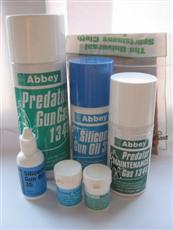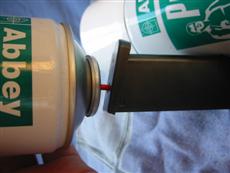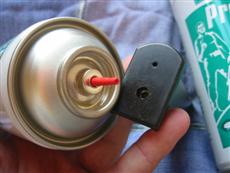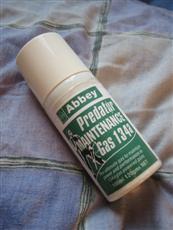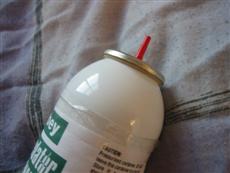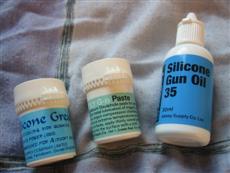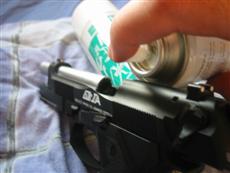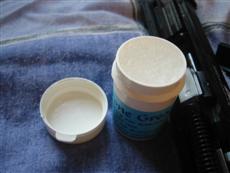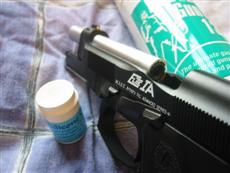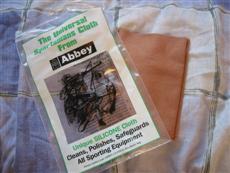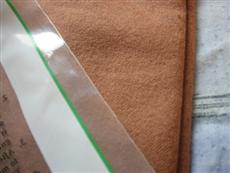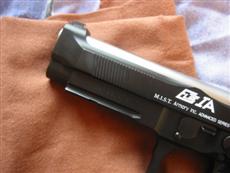I've been somewhat used to buying gear and consumables that have been sourced from HK and Japan in past years. With Airsoft gas propellant this led to the problem that retailers ran out of stock quite often as gas has to be shipped via land based couriers, and sudden consumer rushes for gas would leave retailer high and dry with little to sell. This is not the fault of the retailers, merely that they had to buy gas from overseas via slow shipping methods and supply and demand is somewhat difficult to predict, especially with UK weather... I suppose it can be happily attributed to the growth of Airsoft in the UK that there's such a demand for gas that a UK company by the name of Abbey Supply Ltd (Abbey) has started producing it's own line of gas and lubricant products specifically for Airsoft hobbyists. Now considering that Abbey are relatively new to the Airsoft scene, that's rather an impressive line up. Abbey have actually been producing airgun/pistol and shotgun products for some time, so taking up the Airsoft reigns is not such a huge step for them to take. So lets see what Abbey's products are like.
"...Abbey Predator Gun Gas 134a will improve power and performance: Abbey Predator Gun Gas 134a is available from major airsoft dealers throughout the country and on the internet. 134a is a safe nonflammable gas ideally suited for airsoft gas powered guns. Many manufacturers specify this gas for their guns. Abbey Supply Company have incorporated a new high specification lubricant UPL to provide maximum lubrication to the seals and internal mechanisms of the gun. Ensuring the gun is working correctly with the right lubricant is essential for maximum power and performance. The level of lubricant has been set to make this gas exceptionally good in hop-up guns. Mr Chris Macdonald, Managing Director of Abbey Supply Company Ltd, says 'Abbey Predator Gun Gas 134a delivers improved performance and accuracy making this the gas best suited for skirmishing or plinking. Its large capacity also makes it economical to use.'..." Abbey press release 19 March, 2003 Abbey's development trials matched the HFC134a with this high tech lubricant by the name of UPL, which is apparently prefect for internals of Airsoft guns. Gas tests: Given that I'm very used to HFC22 I didn't quite know what to expect when trialing the new HFC134a, but I didn't need to be worried. The most sensible test to conduct was usability, so I took several GBBs out the toy cupboard that had never had HFC134a breathed through them. Tests were conducted at 15-18 deg C and conducted with a selection of pistols. First up in the test was the KSC M93r (what else?). Being a full auto GBB, this really was the ultimate test for a gas, as good old HFC22 had a habit of freezing up and slowing down somewhat in normal use for me. With both 93rs (1st and 2nd gen) the rate of fire was very good, and there was no cooldown, and blowback was also very impressive, both in full-auto and semi modes. Please note: KSC do not recommend firing the 93r in full auto for extended periods of time as it tends to dry out the gas o-rings. Next up was the WA Shibuya Striker, a fairly standard WA single stack 1911 copy. As you'd expect blowback was crisp and again no cooldown was apparent. The last test was with the Tanaka M629. There's little to go wrong with this piece, but I was interested in trying it out with the 134a to see how the hopup faired. With Abbey;s 134a power was good, and the shots were very consistent. Abbey's Predator 134a ran through the three test pieces like a charm. Power was slightly lower than that achieved with HFC22 in the same conditions but much like the old Pepsi challenge you'd need to have to try both gases at the same time to really spot the minor difference. The lube consistency is spot on with Abbey's 134a, as tests on each replica showed proper lubing after a few magazines, and no evidence of either drying caused by too little lube, or over greasing caused by too much silicone content. Chrono tests: As mentioned in the last review, my chrono has gone walkies so I'm unable to chrono and compare gases at the moment. When I get a replacement I'll update this review with gas FPS comparisons between 134a and 22. Take two bottles to a skirmish? Well I never used to take two different bottles to skirmishes, but I'd consider myself converted. After the SpeedComp died with catastrophic slide breakage (under HFC22) I'll be using HFC134a in the less 'robust' gas replicas I have here. Gas content: Predator 134a contains UPL "a high performance lubricant, especially formulated for the seals and internals of your gun". At this time I don't know the specific chemical construct of this lubricant, nor it's specific quantities in Predator 134a. Can: When you buy gas, your not just buying the gas, but the container that it comes in. With that in mind it's worth taking into account the bottle you get it in. Abbey's can is somewhat of a welcome change from the GreenGas I'm used to using -I've had several greengas cans dint worryingly on me after being dropped and more than a few metal nozzles get bent and then leak gas all over the shop. Abbey's 134a comes in a nice thick walled can with a good nylon nozzle, and it's certainly more field resistant. The nylon nozzle means that it's easier to achieve good gas seals when refilling mags, and that you're incredibly unlikely to damage your inlet valves, as you so easily can with a damaged metal nozzle. Abbey produce their 134a in stocky 450gm cans. As a direct comparison:
As you can see Abbey's can is much heavier, and even though it's the same diameter as HFC's can (at roughly 65mm) there's certainly more liquid gas in the can. HFC Greengas CH2FCF3CH3 (source RefigerantSupply.com R12 page)
Molecular weight: 117.066g per mole Predator 134a (tetrafluoroethane) CH2FCF3 (source RefrigerantSupply.com R134a page)
Molecular weight: 102.031g per mole I won't bore you with lessons in physics and chemistry, but any two gases at the same temperature have the same number of molecules (Avogadro's principle). This means that we can work out how many litres of (expended) gas there is in each can. The assumptions are that the lubricant in the can weighs nothing (not true, but we need to start somewhere), and that the useable quantity of gas is equivalent to the volume of expanded gas once out of the can.
(mole: The amount of particles in a 12 g sample of carbon-12. Approximately 6.02214*1023 particles.) Now if I'm not to far out with my chemistry here that means that there is just over 40% extra gas in an Abbey can by volume. Predator 134a Conclusion: There's no doubting that HFC22 is not good in the grand scheme of things when looking into the longevity of GBBs so it's nice to see some 'home brewed' HFC134a on the market. It's particularly nice to see gas that not only performs well with a selection of replicas but has the correct lube percentages. This is top notch gas, and now my preferred blowback propellant for all my gear, save the select few that require the added 'poke' of HFC22.
"Predator Maintenance Gas 134a was produced when we received reports of new guns sticking and being dry from storage and transit to the UK. Full performance can be restored at the first fill - although obviously it will not repair a mechanical problem" Chris Macdonald, Abbey Please note that the item we reviewed here is a trial batch, and therefore the labels were not ready to be printed on the cans (hence the sticky taped label in the photos) I'm fairly used to striping, cleaning and then spraying my equipment with fairly standard silicon spray before storage. This new maintenance gas reaches parts that other cleaning methods can't reach that easily. I wouldn't consider the maintenance gas as a replacement for your standard cleaning setup - that's not what it is designed for. Instead I'd consider the gas to compliment the standard cleaning procedures nicely. The gas come in 120g cans and with an expected RRP of £8.75. It's also worth noting that the can comes with the usual red nylon nozzle.
134a is a safe nonflammable gas ideally suited for airsoft gas powered guns. Many manufacturers specify this gas for their guns. Abbey Supply Company have incorporated a new high specification lubricant UPL to provide maximum lubrication to the seals and internal mechanisms of the gun. The high lubricant content ensures that where seals and the operating mechanism have dried out in transit they can be reactivated again quickly without stripping the gun. A dry seal may mean underperformance or a misfire. Regular use of Abbey Predator Gun Gas 134a means a gun is operating at maximum performance. Mr Chris Macdonald, Managing Director of Abbey Supply Company Ltd, says 'Many gun spend a long time in transit and storage before purchase, using Abbey Predator Maintenance Gas 134a restores a gun to its original high performance.'..." Abbey press release 19 March, 2003 If you're looking to store your equipment away a quick blow through with maintenance gas will help preserve the seals - a clean through with maintenance gas every few skirmishes will help keep the internals in good condition, and for pieces with dry seals maintenance gas will help get everything squeaky clean and lubed again. Abbey's maintenance gas is innovative and a rather welcome idea. Silicone Grease: Next up on the list of handy products to help look after your gas driven replicas is Silicone Grease. This isn't quite the same as Gun Oil 35, as the stuff in these little pots is rather like vaseline. You normally use this on internal parts that need more long term greasing, and where '35 could well dry off. Silicon grease will keep plastic surfaces running smoothly against each other, and when used on things such as recoil springs will not only encourage their friction free motion but also help protect them from moisture and therefore rust. When this grease is used with contact surfaces such as the parts where nozzles and mag/valve seals come into play it will also help reduce power loss through gas leakage.
You may not think that there's a huge need for such grease in the Airsoft world of rubber and plastic, but do remember that there's a lot of upgraded metal slides and frames out there and if you want to ensure a smooth trigger action on your BB-IPSC piece then this really is 'miracle goo'. For application it's best to clean what you plan to apply it to, apply a thin layer and then buff it in with a cloth. I'm not that familiar with the chemical content of the grease and it's properties, but here's some information from the International Molybdenum Association (yup this grease is so popular it gets its own website, and club). "...Molybdenum disulphide, the most common natural form of molybdenum, is extracted from ore and then purified for direct use in lubricants. This material by itself, since it has a layered structure, makes a very efficient lubricant. These layers can slide over each other at the molecular level, allowing the surfaces of steel and other metals to move fluidly, even under severe pressures, as bearing surfaces. Since molybdenum disulphide is of geothermal origin, it has the durability to withstand heat and pressure. This is particularly true if small amounts of sulphur are available to react with iron and provide a sulphide layer which is compatible with molybdenum sulphide in maintaining the lubricating film. Molybdenum disulphide is inert to many chemicals and will perform under a vacuum where graphite fails..." (source: International Molybdenum Association) Retail price list: As of 03/2003 here's the MRP price list for the Abbey products found in this article. Please note that these are MRPs so not necessarily the price that you will find a retailer stocking them at. Abbey do not sell direct to the public but do welcome trade enquiries. Prices reflect the cost per item, and where applicable I have listed the multiples that Abbey will supply in:
Enquiries should be directed to to Chris Macdonald, Abbey Supply Company Ltd,Tel: 01202 603067, Email: chris@abbeysupply.com Abbey Supply Company Limited, 8 Balena Close, Creekmoor Industrial Estate, Poole, Dorset BH17 7DB
Comment on this review in the forums Last modified: Tuesday, April 8, 2003 5:40 PM Copyright 2003 ArniesAirsoft
|
